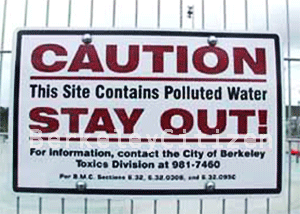
Zoning Review of Harrison Fields
and Skate Park
To: Mark Rhoades, Zoning Adjustments Board
From L A Wood, December 19, 2000Re: Request for a Review of Use Permit #99-10000112 at Fifth and Harrison Streets
The recent discovery of the chromium 6 groundwater plume at the Harrison play fields and skate park is quite disturbing, given the many times the issue of the project's inadequate environmental review has been publicly raised. Now, the escalating costs for city staff management of the construction and cleanup can be directly linked to the Department Parks and Waterfront Division project team's failed management of the site investigation and use permit processes. Please consider the following:
UC's Phase One Report
Dated 1993, UC's Phase One report is the oldest known environmental investigation of the Harrison site. In a meeting with the city management it was revealed that this report was never used in any of the city's initial site evaluations as the recent staff report to council has claimed. Instead, this report appears to have been hidden away by project staff and has only now surfaced after the discovery of the chrome 6 plume and after my public challenge to the project team to produce a Phase One report for the Harrison parcel.
The 1993 report's true value is that it identifies WRE Color Tech as a possible pollution source concern. We now know this to be the source of the chromium plume. Unquestionably, had the report been available earlier to DTSC and others evaluating groundwater risks, and especially to the public and CEQA processes for the site, the chrome 6 groundwater plume would have been identified before construction began.
The Odgen Report
The Odgen report, produced in 1997, was the first of the city-initiated environmental investigations of the site. At that time, some public concerns were raised about evaluating the site soils because the University of California, the property owner, was using the parcel for soil stockpiling. And again, just prior to the completion of the sale of the property to the city, UC began stockpiling soils, moving approximately 20,000 yards from their Albany Village construction site onto the Harrison property.
Stockpiling uncharacterized soils is an issue because of the potential for encountering contamination. This most recent addition of soils was eventually spread across the entire site. Yet, the city made no objection. This further supports my claim that the Odgen report should not be used to represent the soil conditions at the site.
Groundwater
Even more troubling than the site's convoluted soil investigations is the project team's failure to address the site's complex hydrology. The project team ignored the fact that the parcel is bordered by a creek and is in a flood control area. Harrison's hydrology report should include the identification of the relationship of the shallow groundwater to the surface water in the creek, the site's groundwater recharging of Codornices Creek, and the impact of the flood plain on the site's groundwater before it concludes that no exposure pathways from the groundwater exist on site.
The concern over the management of the contaminated groundwater at the site was established long before the chromium 6 plume appeared. Yet, there are no clear provisions in the current use permit about dewatering and the necessity for waste treatment. A dewatering provision should be formally incorporated into the use permit.
The special condition 9-C of the use permit requires the project to submit a flood plain mitigation plan prior to any construction. A look last week at the use permit revealed the document to be missing.
CEQA Review
The project team has also said that the staff was surprised over the chromium 6 plume because the skate park design and construction came late in the project. The problem began when the project staff failed to recognize the need for a CEQA review of just the skateboard park. The deep bowl design should have required another CEQA study. Why was an additional CEQA study not required for the skate park? The temporarily abandoned skate park construction dewatering system does not provide for any treatment of solvents or chrome, but apparently is designed to loop this contaminated groundwater associated with the dewatering process into the storm
Finally, it's fair to ask whether the city took reasonable steps to identify the chromium 6 problem. Frankly, a professional management team would have anticipated the problems with the site characterization of a known contaminated industrial property and would have performed a more extensive environmental review. Where was the support from the city's Toxics Management Division? It is now evident that the inexperienced project team had little understanding about the environmental assessment process and even less knowledge about the science.
Berkeley Citizen © 2003-2020
All Rights Reserved
All Rights Reserved
